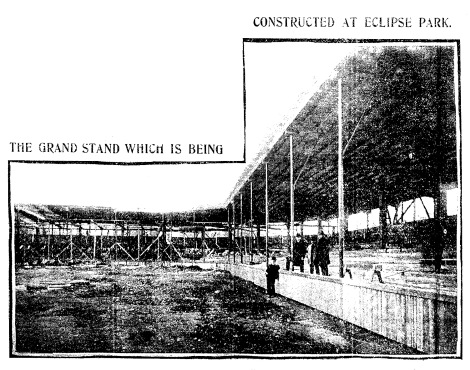After starting research for this project some months back, my published account of Louisville’s Eclipse Park was mailed out yesterday to my subscribers. This was my 35th issue of the American Association Almanac, a project I started back in November of 2001.
The issue was originally intended to come out as one, but the length exceeded what I would normally be able to produce, and mailing costs have gone up so much I decided it was most prudent to cut it in half. As it is, the content approaches 25,000 words and includes the early history of the home site of the American Association’s Louisville Colonels. Known also as Eclipse Park III, the facility sat at the corner of 7th and Kentucky Streets, one mile south-southwest of the city’s center. As the story goes, Louisville was not originally slated to become a franchise in the American Association when plans were laid to start the new league in 1901. Instead, Omaha was to be the entrant, but the league owners quickly realized this would make travel expenses unbalanced, making the Omaha choice an unwise one. So George Tebeau was enlisted to go forth into uncharted waters. He had no contacts in Louisville, but he had the will to build a ballpark there and put a team in a city which had been intimately familiar with major league baseball for years, through the 1899 season. Tebeau encountered many difficulties, documented in the text of this issue, and it makes for interesting reading. I’ve examined various sources in an attempt to portray the situation as historically accurate as possible, and I chronicle the construction of the park. Included is a thorough account of the first game played there, as well as a section on the home runs hit at the park from 1902-11. Deadball fans will recognize that this was a period of slower offensive output, but baseball fans generally may be surprised at the number of home runs hit in Louisville during the league’s first decade.
Featured are 15 graphics, including a splendid photograph of the scoreboard at Eclipse Park, used by permission (it cost me thirty-five bucks) from the University of Louisville’s Eckstrom Library, which incidentally, was completely inflexible with me when I tried to work with them to obtain permission to obtain the use of additional photos at a discount, but they chose to stand in the way of public scholarship. Regardless of the obstacles, there is a host of other graphics included in this issue which help add to the overall story of Eclipse Park.
The issue sells for $8.00 + postage. If you wish to subscribe you will receive a 10% discount if you mention this blog. Subscription rates for one year: $21.00. For two years, $36.00.
Please feel free to contact me with any questions you might have: pureout@msn.com
Also, please see my blogspot blog at http://www.almanacpark.blogspot.com